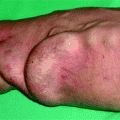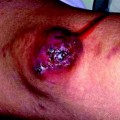Fig. 1.1
This patient was eventually dialyzed on a right brachial–basilic fistula. The multiple scars on her forearm were a result of several attempts at creation and revision of antecedent accesses by open surgery. They are lingering testament of the strong points of pursuing treatment of dialysis access complications by endovascular means
The relative success of endovascular dilation seemed to conjure its omnipotence as a universal panacea for all stenotic lesions in the vascular access circuit, leaving little role for alternative approaches like surgery. It is however well-known that certain lesions such as juxta-anastomotic stenoses in forearm autogenous arteriovenous fistulas (AVFs) respond better to surgical revision than to endovascular treatment [6]. Despite restenosis, rethrombosis, modest patency rates, and need for reintervention, nephrologists and patients alike have come to accept endovascular interventions as the standard of care, mostly as result of their minimal invasiveness and ease of being performed in an ambulatory setting with little recourse to general anesthesia. On the other hand, an end-stage access requiring frequent endovascular reintervention should include a multidisciplinary strategy for creation of new vascular access, less prone to repeated failures.
Initially the sole preserve of interventional radiologists, endovascular access interventions have come a long way and are now also performed by a new generation of vascular surgeons and nephrologists, particularly in centers lacking a strong and committed radiology-led interventional vascular access service. The training, accreditation, maintenance of competency, and skills of these new players pose a number of challenges, including turf battles, lack of common definitions, and reporting standards. The general consensus, nonetheless, is that these challenges can only be resolved through multidisciplinary collaboration and more formalized training.
As the pioneer interventional radiologists became more experienced in more challenging accesses and patients (e.g., in elderly, diabetics, and obese), they ventured into unchartered territories by addressing hitherto untreatable lesions. In the 1990s, they began treating nonmaturating fistulas followed some years later by dilation of long inflow radial artery stenoses [7, 8].
A major breakthrough in the late 1980s was the percutaneous declotting of thrombosed vascular accesses with relatively greater ease and success using mechanical techniques. Although earlier published attempts in 1985 reported disappointing results [9, 10], this innovative approach became timely in the wake of a rising dependence on prosthetic polytetrafluoroethylene (PTFE) grafts (Gore-Tex®) with their associated high thrombosis rates. Quick restoration of graft patency by interventional radiologists reduced dependence on temporary dialysis catheters. Declotting was subsequently adapted to thrombosed AVFs as evidenced by the first publications in 2000, which reported that over 90 % of thrombosed AVFs could be salvaged by endovascular means [11]. Prior to that, the majority of thrombosed AVFs were generally deemed unsalvageable. Unfortunately, the abandonment of thrombosed AVFs is still the rule in many centers lacking the expertise and tools to carry out endovascular declotting.
Endovascular treatment of vascular access complications nonetheless shares the same challenges and shortfalls as the surgical approach. Many cases have unique complexities. Success is greatly dependent on the skill and experience of the operator, usually acquired at the expense of a steep learning curve. Therefore, it is not an activity to be done on a part-time basis or with a sense of detachment or lack of commitment, all of which may limit one’s ability to remain up to date.
Stay updated, free articles. Join our Telegram channel

Full access? Get Clinical Tree






